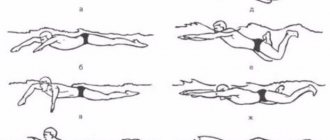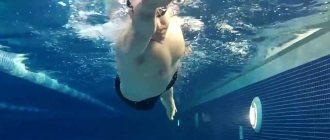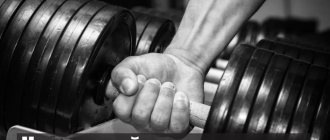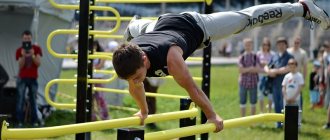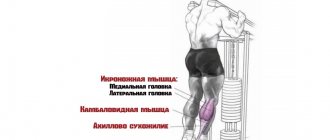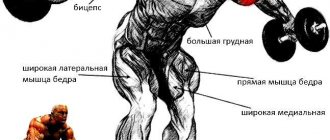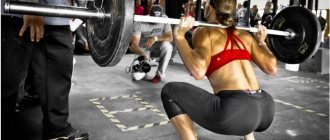- The benefits of swimming
- Contraindications
- Butterfly swimming technique Arm movements
- Movements of the body and legs
- Breath
Butterfly swimming appeared much later than crawl, backstroke and breaststroke. This type of swimming is a modernized technique of breaststroke swimming. Changes in swimming techniques were made gradually over 3 years. First they made changes to the movements of the arms, then they changed the technique of moving the legs and finally they changed the swimming technique so that the head was lowered face down.
Butterfly is the most difficult, fast and tiring swimming style. When performing movements, the whole body is involved. Movements are performed symmetrically.
When you look at a swimmer, this style is somewhat reminiscent of dolphin swimming. Taking a closer look at how the movements of the hands are performed from above, you understand why this style has such a name. Butterfly translated from English means “butterfly”. Hand movements resemble the flapping of a butterfly's wings.
Swimming is recommended for all people, regardless of age and health status. Can everyone really swim with this style? The technique of performing the movements is quite complex, but if you learn how to perform it, then why not.
How to swim correctly
The butterfly style is the most difficult swimming technique. This is explained by the need to achieve high speed, and this requires not only physical effort. What is important here is maintaining balance, coordination of movements, and coordinated work of all parts of the body.
Butterfly is similar in its technique to the movement of butterfly wings - while swimming, a person moves his arms and legs in the same way as an insect during flight. This is where the name “butterfly” came from, which means “butterfly” in English. In Russia, this style of swimming has a second name - “dolphin”, because the movements are similar to the behavior of frolicking sea inhabitants.
The butterfly swimming technique is presented as follows:
- The swimmer uses his hands to scoop up the water - this is done simultaneously with two straight arms that are thrown above his head.
- Simultaneously with the hands, the person immerses the chest lower above the water level, and the pelvis rises higher.
- The lifting of the pelvis is accompanied by the simultaneous movement of the legs - the knees drop a little lower, and the feet “push off” from the water.
As a result, it turns out that the swimmer makes two movements with which he moves forward - grabbing the water with his hands and pushing away the body with his feet. In order to stay on the water, you will have to make two push-offs with your feet for one grab of the water with your hands.
How to learn?
The instructions on “how to swim butterfly style quickly” come down to just one piece of advice - follow the correct technique of movements. Accurate adherence to its aspects will literally force your body to perform the correct manipulations. It itself will intuitively correctly understand how to make a wave, when to inhale air, at what moment to go under water. It's like with balance - if you catch it once, you won't fall off the bike again.
An analysis of the butterfly swimming technique shows that it has absorbed all the best from the freestyle and breaststroke, seasoning everything with its own unique spice. The result was something very interesting - more powerful, no less fast, and certainly spectacular.
Until you have mastered crawl or breaststroke swimming, it is too early to move on to the butt. If there are no difficulties with the first two, increase your speed and develop endurance. Gradually try the butterfly technique. By the way, men love this style more, because it allows them to demonstrate their excellent physical shape and strong training in a favorable light.
Movement of the body in the “dolphin” way
The presented technique must be performed in full accordance with the instructions, since only then can you get everything you need from it. Why is butterfly used? With its help, a person strengthens all the muscles of the body, which is necessary for the strength of the muscle corset and the achievement of a sculpted body. Therefore, the swimmer must take into account all the subtleties of body movement:
- The body movements are wave-like - only a sharp throw of the arms is carried out to grab the water. The rest of the body forms a kind of “wave”.
- The body moves up and down, which should be accompanied by proper breathing.
- The starting position of a person is important - he stands straight, legs together, arms raised above his head and in a straight position.
- The lifting of the upper back is accompanied by the immersion of the pelvis and legs down. Conversely, lowering the shoulder girdle entails raising the pelvis and feet.
Correct technique is achieved only by tensing the abdominal and back muscles. Therefore, a swimmer with leg or arm injuries can recover in the pool using the butterfly swimming style.
Butterfly style swimming technique
What muscles does the butterfly style use?
One of the most actively working muscle groups during a swim is the shoulders, as well as the back muscles and triceps. The pectoral muscles, shoulders and legs are also stressed.
In addition, any swimming technique can be called good cardio training - this is largely why athletes look so fit.
Advantages of butterfly swimming.
— this style requires special control over your body and body movements, thanks to which swimmers manage the balance of their body well even on land.
— butterfly will help you develop your endurance and strengthen the muscles of the upper and lower half of your body.
- also, this technique is one of the most beautiful, because correctly performed exercises look graceful and flawless.
Before mastering the butterfly, you need to master the breaststroke, which will become the basis of the butterfly technique. The article “Breaststroke Swimming Technique” will help you with this.
In this article, you will learn about the advantages of this style, receive recommendations for mastering it, and familiarize yourself with the list of exercises that should be performed on land and land to master this style.
Leg movement technique
An incorrectly mastered dolphin swimming style will lead to the swimmer sinking to the bottom. And here the movements of the legs play a huge role, when the movement is performed twice as fast as grasping water with the hands.
Otherwise, it is important to follow the following rules:
- The swimmer's legs must stay together. They make wave-like movements, pushing off the water.
- The wave created by the legs is a continuation of the wave started by the arms and upper body.
- By pushing off with the legs, the person lifts the upper body upward. For a full lift, do two pushes for each lift - the first two help lift the head and shoulders, and the second two help the back.
- To push with your legs you need to bend your knees.
Footwork
Footwork
The legs in butterfly are placed side by side and make wave-like movements starting in the lower back and ending in the shins. These movements are a continuation of the wave-like movements of the torso.
The efforts from the legs are aimed at lifting the swimmer's upper body out of the water - the first two kicks (weak down and strong up) help raise the head and shoulders, the second two – the back.
The legs work with an average amplitude; during the strike, the swimmer's pelvis and buttocks rise to the surface of the vortex, followed by the hips. After which the pelvis and hips drop down, and the legs bend at the knees for the next blow.
The footwork is somewhat reminiscent of the crawl, but the differences are still obvious: the limbs work simultaneously , and not in turn, and other muscle groups are involved. In addition, during movement the feet are not pulled away from themselves, as in the crawl, but are in a slightly tense state at approximately an angle of 45°.
The similarity is that the movements from the knees are the same as in the crawl - the leg seems to turn into a whip making blows . Accordingly, during swimming, the angle between the thigh and lower leg first decreases, and then increases, and so on until the end of the cycle.
And just as in the crawl, the movement of the lower leg does not come from the knee, but from the whole body : in this case, first the back bends in a wave-like manner, then the lower back and hips, and then the lower part of the legs.
In addition to the function of movement, the legs also perform a coordination function and contribute to a sense of rhythm.
The leg technique is shown well here:
Hand movement technique
The hands help the athlete move the body forward, so they work not only correctly, but also in compliance with the rhythm set by the legs. The upper limbs jerk and return to the starting position.
Hand stroke
The snatch involves a stroke that is similar to the movement of breaststroke. To do this, raise both hands, palms down, then lower them sharply down and spread them in different directions. After the stroke, the limbs spread around the body. At the same time, they are half-bent at the elbows, which are located slightly higher than the forearms and hands.
Then, with an increased speed of ejection, they create a push - a strong stroke is obtained. At the same time, the upper body rises. The stroke is completed by spreading the upper limbs to the sides and then raising them.
Return to original position
The butterfly style technique in swimming begins with taking the correct starting position. At this time, the swimmer’s arms are raised up, palms pointing away from themselves - therefore, they are lowered into the water with their palms down. The return is carried out after spreading the upper limbs to the sides. The arms are in a straight position. Next, you need to lift them completely above your head, bringing them to their starting position. Then the stroke is performed in accordance with the above instructions.
Swimming technique - butterfly
The content of the article
Butterfly is a style of front swimming in which the athlete performs simultaneous and symmetrical movements with the left and right parts of the body, simultaneous movements with both arms in the form of a powerful stroke, the execution of which lifts the upper part of the body above the water, while simultaneously performing symmetrical kicks from the pelvis. This swimming style is the second fastest, after front crawl.
During sports competitions, three sets of medals are played out: 50, 100 and 200 m. The third stage of the 4x100 medley relay and the first stage of the 200 and 400 m medley relay are also swam in this way. Highly qualified swimmers always use a variation of the butterfly stroke - the dolphin - at competitions. A distinctive feature of this type of butterfly is that both hands, having completed the stroke, perform a preparatory movement under water, the legs continuously move like a dolphin’s tail up and down, two complete kicks with the feet down fall on one completed cycle of arm movements. Hand movements must be simultaneous and symmetrical; the requirement also applies to leg movements and is specified in the competition rules.
A general idea of the dolphin swimming technique:
- after moving through the air, the hands enter the water at shoulder width, the palms press the water surface, maintaining optimal rigidity in the wrist and elbow joints. The elbows move slightly above the hands, the swimmer looks down and forward. The legs perform one energetic downward kick of the foot.
- the hands are turned, palms facing out, continue to smoothly press down on the water, the swimmer slides on the oncoming flow, begins to grab with his hands, the legs complete the blow with the feet down. The swimmer continues to look down in front.
- the arms perform a pull-up, bending moderately at the elbow joints; after striking down, the legs reach the surface of the water, giving the body a streamlined position. The swimmer looks forward and begins to exhale smoothly into the water.
- the arm stroke continues, the arms continue to bend at the elbow joints, the hands come closer together under the swimmer’s body, the hips begin to move down, the legs bend at the hip and knee joints for the next kick with the feet down, the swimmer intensifies the exhalation.
- performed most energetically, part of a full cycle of movements: the arms continue the stroke, pushing off the water, the legs perform a second kick with the feet down, the shoulder girdle and head are on the surface of the water, the swimmer exhales, pushing the chin forward and preparing to begin inhaling.
- The downward kick is completed, the front of the swimmer's body is extended forward and slightly upward, the arms leave the water, and the swimmer inhales.
- the arms perform movements above the water, the head lowers its face into the water, the legs, after striking the feet down, actively reach the surface of the water and begin to bend for the next blow.
Technique of leg movements in butterfly swimming
In butterfly, leg movements begin from the pelvis and hips. Following them, the legs and feet begin to move. The legs bend sequentially and extend at the hip, knee, and ankle joints. The hips perform movements at the very surface of the water, with a moderate swing, the feet in the water column. The main working phase is an energetic downward kick with the feet; after the downward kick, the legs actively reach the surface of the water and bend again for the next blow. The movement of the legs resembles a sweep, continuous and elastic, making a significant contribution to the creation of forces that propel the swimmer forward.
Technique of arm movements and breathing in butterfly swimming
The hands are of paramount importance in the butterfly swimming method and they are assigned the leading role, because it is they who control the movements of the legs and breathing. The hand movement technique can be divided into several phases:
- capture phase . It begins after the hands enter the water, the hands move outward and slightly downward, capturing the water. Having felt the support of the water, the swimmer moves on to the main part of the stroke.
- pull-up phase . The arms bend at the elbow joints and move from front to back, resting well on the water with the hands and forearms. Towards the middle of the stroke, when the pulling turns into pushing, the hands come together under the stomach, the palms are turned strictly back.
- repulsion phase . With a smooth, energetic movement, the hands are directed back and out. The row ends at the hips by straightening the arms at the elbow joints. After this, turn your hands with your little fingers up and relax, your hands come out of the water.
- hands coming out of the water . It is carried out with a quick swinging movement. First, the elbows appear above the water, then the forearms and hands leave the water behind the line, also slightly away from the hips. At this moment they are relaxed and turn their palms inward.
- movement of hands above water . It occurs in the form of a smooth swing forward to the sides, the arms are almost straight and relaxed. The swimmer's shoulder girdle rises slightly above the surface of the water, which helps move the arms through the air.
- entry of hands into the water . Occurs approximately shoulder width apart. The hands are the first to submerge in the water, followed by the forearms and shoulders.
Breathing is strictly coordinated with hand movements. When the arms enter the water, the swimmer's head is face down. When performing a stroke with his hands, the swimmer smoothly straightens his neck, turns his head to face forward and at the end of the stroke with his hands he rises above the surface of the water. Inhale along with the shoulder girdle. Inhalation occurs when the hands come out of the water. At this time, the chin moves at the very surface of the water, the swimmer’s gaze is directed forward, and the inhalation ends in the first half of the movement of the arms above the water. The athlete's head is again lowered face down into the water.
General coordination of movements in the butterfly swimming method
The most rational is to use 2-impact coordination of movements with the arms and legs, with inhalation performed immediately after completing the arm stroke, which should ensure the swimmer’s continuous movement forward, optimizing energy costs. The first downward blow of the feet occurs when the hands enter the water and grab the water with the hands. The second downward kick of the feet is coordinated with the second half of the stroke and the pushing of the hands out of the water. The simultaneous rowing movement of the arms and legs helps the swimmer's body move forward and upward as he inhales and carries his arms above the water.
The optimal rate of movement when swimming as a dolphin at distances of 100 and 200 m is 56 cycles per minute.
You might be interested in reading:
- Swimming technique - back crawl. Back crawl is a type of swimming, the basis of which is stroke, alternating arm movements combined with footwork. The structure of the back crawl is similar to the front crawl, only inverted...
- History of the development of swimming styles Brief overview of swimming styles Swimming has been part of human history for a very long time. Unfortunately, it is impossible to establish exactly how our ancestors swam. Analyzing the rock paintings, we can draw the following conclusion: the method of swimming of the ancestors...
- Technique of crawl swimming Nikita Lobintsev (Russia) during the 200 m freestyle in the preliminary men's swimming competition at the XXXI Summer Olympics. The front crawl is rightfully the most popular and fastest…
Basic mistakes
It is difficult to achieve perfect technique with the presented swimming style, since novice swimmers make a number of mistakes. This is due to the lack of necessary coordination of movement and proper experience. All beginning swimmers make typical mistakes when mastering the technique.
Lack of pelvic function
Beginning swimmers think that the lifting of the pelvis occurs only due to the movement of the limbs. This is wrong. When creating a wave, you have to raise your pelvis and lower it in time. The wave is done with the whole body, and not just with the legs and arms.
Improper footwork
The following common mistakes are highlighted in the question presented:
- The swimmer raises his legs too high, causing them to rise above the water level. This should not happen - your legs are under water throughout the entire swim.
- The legs do not work synchronously - with each other and with the arms.
- The swimmer pushes off by bending the knees, and the push should come from the work of the hips.
Improper technique in the lower extremities often leads to knee injuries.
Incorrect hand position when entering the water
Such a mistake results in the lack of the required stroke and the person moving forward. Hands in the starting position should be at shoulder level - extended over the shoulders. Otherwise, less force will be exerted on the water resistance, so the required push will not follow.
Low hand speed
At low speed it is impossible to make the desired stroke. Often, novice athletes go into deep water because they feel strong pressure on their shoulder joints. To avoid this, you need to work your limbs faster. Otherwise, you may get a shoulder injury.
Short stroke
Beginners also make a short stroke, which is accompanied by an increased bending of the body. Therefore, the stroke force does not correspond to the required level.
Improper breathing
Correct breathing sets the desired rhythm for raising the head. If this is not the case, neck strain occurs, which negatively affects the overall well-being of the athlete.
Newbie mistakes
- Dipping your hands too quickly when returning increases resistance in the water and decreases speed.
- Bringing your arms together or spreading them too far will reduce the stroke.
- Excessively rapid exhalation - it must end on the eve of the next inhalation, otherwise the swimmer may not have enough air.
- Holding your head above the water while inhaling slows down the return movement of the body.
- When pulling up and pushing off the body, there is no need to bend or “sag” your elbows - this will negatively affect speed.
- Before moving your legs strongly, you should not bend your shins too much.
Turning technique
Once the athlete has covered the length of the pool, he makes a turn. In this case, first you need to touch the side with slightly bent arms. Then they lift off the side with one hand and begin to turn it towards the opposite bank. Thus, the body follows the hand “automatically”.
After moving the body away from the side with half-bent legs, you need to touch it and turn the body completely, using support under your feet. The body takes a horizontal position on the water, after which a high-quality and strong push is made with the legs from the side.
Breath
Inhale
When swimming as a dolphin, significant attention should be paid to breathing. It is important to coordinate this process with the movement of the hands: the only opportunity for air intake is the moment when the shoulder girdle rises out of the water , and the hands move forward above its surface.
When pulling the arms from behind, the neck is activated, the head also rises at this moment, the swimmer’s gaze is directed to the side in front and slightly down (for better body balancing).
While raising his hands from the water, a person inhales, and a little before lowering them into the water, his head drops.
The moment of inhalation is shown in this illustration:
Exhalation
It is better to exhale air through the mouth and nose at the same time , the latter prevents water from entering the nose.
Typically, swimmers breathe once per full arm cycle, but many trained athletes breathe only every other rise from the water, this saves energy on additional neck work and reduces the likelihood of hyperventilation.
Underwater technology
The butterfly swimming technique is suitable for moving underwater. Using the presented style, they dive to a depth in an open reservoir, and also swim some distance in the pool during competitions.
But to swim underwater, you must follow the following instructions:
- To begin with, stretch your arms up and in front of you, placing your palms together.
- Next, they dive into the water, hold their breath and make wave-like movements.
- When swimming underwater, exhale smoothly through your nose and mouth at the same time to avoid choking.
When surfacing, take a deep breath and continue swimming in the traditional way.
The most common mistakes
There are a number of mistakes when swimming with this style, which are made by both beginners and experienced athletes. Here are just a few of them:
- At the moment of entering the water, the hands are at too great or insufficient distance from each other. The optimal distance is shoulder width apart.
- The arms are pressed too tightly to the body, which does not allow for a full stroke. This error is characterized by the position of the shoulders being too low under water.
- Too much distance between the hands can result in reduced speed. This is due to water resistance and reduced gripping efficiency.
- Extending your legs above the water while moving, which also entails a decrease in speed.
- Incorrect breathing technique - inhaling too late or, conversely, early.
- Improper execution of leg movements, as well as non-simultaneous execution of certain movements, leads to a decrease in swimming speed.
Despite the complexity of such a swimming style as butterfly, it is still worth learning. This style can help strengthen muscles throughout the body, as well as get rid of excess weight.
Similar articles:
- Independent swimming lessons
- Teaching children to swim: benefits and exercises
- Underwater swimming: technique overview
Sports start
Athletes observe not only swimming technique, but also proper immersion in water. To do this, you need to stand on the side in the appropriate way for the butterfly style. Here the following sequence is observed:
- In the starting position, standing on the side, the athlete needs to first stand straight and then bend his knees slightly. Then the body is lowered at a right angle - the body is parallel to the water. There is a small distance between the feet - no more than 20 cm.
- Fingers reach the edge line.
- Hands are placed straight, back.
- At the start, the athlete needs to quickly and strongly push off from the boot, while simultaneously putting his hands forward and placing them with his palms. The arms are extended above the head for a smooth descent into the water.
They don’t dive from the side shallowly, but they don’t dive to the bottom either. The athlete must maintain a body tilt of 30 degrees to the surface of the water. They swim underwater, first slightly downwards, then parallel to the surface of the water, and then rise up. If you have problems surfacing, it is recommended to use your hands.
What is butterfly?
A butterfly swimmer rises above the surface of the water at the beginning of the cycle of movements, after which he makes a sweeping, strong stroke with both hands. At the same time, working with your feet and hitting them on the water, it creates additional acceleration. The complexity of the style lies in the fact that, firstly, there is a serious load on the muscles, which requires a lot of endurance, and secondly, due to such loads, it is quite difficult for a beginner to perform all movements technically correctly.
Techniques for diving in length and depth How to choose the right swimming cap for swimming in the pool
Read with the article
Long and deep diving technique
close
open
x
The main movement in butterfly, with the help of which speed is set and maintained, is the stroke movement of the arms. Without mastering the butterfly technique perfectly, only through the correct technique of performing arm movements can you develop up to 80 percent of the speed possible when swimming with this style. Hand movements can be divided into the following phases:
The benefits of butterfly swimming
The butterfly style is interesting, helping to strengthen the entire human muscular corset. This has a positive effect on endurance and improved appearance. It is especially useful to use the style in the pool while losing weight - it is recommended to replace workouts in the gym with classes in the pool if the person losing weight has had joint injuries or been diagnosed with other musculoskeletal diseases.
Dear readers, if you see a mistake in our article, write to us about it in the comments. We will definitely fix it. Thank you!
Share this article with your friends:
Key aspects of working on butterfly style technique
The key aspects of the butterfly style technique include two essential elements - the undulating movement of the body and the arm stroke. They are worked out separately and in combination with each other.
Many highlight the third key point - footwork, however, I consider it a continuation of the wave-like movements of the body. This point of view is quite consistent with the concept of the “front” butterfly technique that is widespread today.
I also recommend reading the article “What muscles work when swimming in a pool?”
Exercises
— A series of swims of 3 x 200 meters, the body is extended or moving on the stomach with a board, increasing activity as swims 1-3, 4-6, 7-8 are completed.
— A series of swims of 3 x 100 meters, arms down, covering the distance at maximum speed, best average time.
Movement on the side. The lower arm is extended, the upper arm is lowered, alternating movements of the sides. This exercise allows you to work your hips behind or in front of an imaginary center line of the body.
Working with monofins. Performing pushes for 25 meters, followed by a short rest break, a series of swims of 3 x 100 meters, every 25 or 15 meters movement under water with an extended body position (alternating actions on the back and on the stomach) plus movement on the side, alternating left and right when turning over.
Vertical leg movements with load. Practicing straight vertical movements and balanced hip work.
Push and swim. A series of swims of 3 x 100 meters, the swimmer completes 50 meters using only his legs / 50 meters in the butterfly style, followed by a rest period, gradually increasing the load 1-3, 4-6, 7-8 (the sixth swim must be completed faster than the third, the eighth faster sixth).
Start. You need to do 25 repetitions; odd-numbered swims are performed underwater using only the legs, even-numbered swims are performed in the butterfly style.
Movement only with legs, arms down. The exercise is done in a mask and snorkel with or without monofins. It develops the skills of relaxing the neck muscles in the presence of water pressure, which is created by the forward movement of the head, despite its slight swaying.
Pushing hands and exiting the water
Based on all the information presented above, the next question logically arises: at what point should you reduce the force applied to perform the stroke, and when should you remove your hands from the water? The arms should push until maximum driving force is maintained just before the natural lift of the fingers, which occurs at the bottom of the stroke.
Once the toes begin to rise, the swimmer lowers the hips, leaving the arms unable to generate propulsive force by pushing through the water. Removing the arms from it during a “late” stroke is delayed, since the athlete does not have enough time to accumulate the forces required for a quick and effective transition to the recovery phase.
When using the "front" technique of the butterfly style, the arms push the water only to the end point, allowing maximum driving force to be generated rather than wasting energy on an inefficient long stroke. It is also worth noting that thanks to the early stroke, the swimmer has the opportunity to build up the strength to quickly and efficiently remove the arms from the water and enter the recovery phase.
Foot push is the final stage of body movement
The thrust of the feet generates the driving force at the end of the wave-like movement. This push engages the potential of the feet (which are positioned at the correct angle), quadriceps, and hamstrings.
This push can be seen as a source of additional driving force or an additional explosive movement that completes the body wave, like the blow of a whip or an exclamation mark at the end of a sentence. In any case, the effectiveness of the push depends on the correct execution of the wave-like movement of the body.
However, there is one very important point - the swimmer needs to monitor the proportionality of the push, since too strong actions of the feet can cause a very strong body wave or excessive bending of the legs at the knees.
The push should be uniform, but at the same time sharp. The negative effects of excessive pushing will be discussed later in this article on pushing coordination and hand work. Below, the term “push” or “leg movement” will be understood as a complete wave-like movement, including the push of the feet at the end of the wave.
Although foot propulsion may seem to depend on the body's wave motion, practicing foot propulsion remains a very important part of a butterfly swimmer's training program. Their special training with the help of special exercises allows you to increase the endurance of the leg muscles, increase the flexibility of the feet and ankles and influences the correct functioning of the hips during wave-like movements.
These exercises can be performed in different positions - on the back, side or stomach using a variety of tools, including boards of different sizes and long, short fins and monofins. Trainers should use monofins regularly, as this can significantly increase the effectiveness of training. Swimming with them helps to master the wave-like movements of the body (especially with the hips), increases the flexibility of the foot, develops the endurance of different muscle groups and streamlines the body.
The sets of exercises described below are designed to help improve the shape of the leg muscles and master or improve the undulating movements of the body and the correct technique of butterfly swimming.
Hips and effective leg action
Probably the most important thing when performing undulating movements of the body is the balance and completeness of the hips, which includes not only vertical movements, but also thrusts of the pelvis.
It is worth noting that their implementation requires coordinated work of the back muscles during vertical movements and the lower abdominal muscles during pelvic thrusts, which illustrates the importance of the general physical endurance and preparation described above. Poor hip action, especially in propulsion, is commonly seen in swimmers who are unable to perform well using their legs alone. And this seems quite logical.
Effective kicking means that the feet, both when lifting and lowering, are in the correct position to generate movement in the water in a line just opposite the desired forward line of motion. This is achieved in part due to the high flexibility of the foot and ankle area. However, proper hip function is necessary to achieve the desired foot angle.
The legs follow the hips as they move up and down. These actions are accompanied by a natural bending of the legs after the movement of the body. Next, the feet take a position in accordance with this wave-like movement of the body. In the absence of forward-directed work of the hips, the wave-like movement of the body is interrupted, and in order for the feet to take the required position at an angle, the swimmer is forced, making special efforts, to bend his legs at the knees, while with the wave-like movement of the body, the legs bend spontaneously.
This is because the feet, being at the very end of a short wave line (from the knees to the feet, and not from the hips to the feet, which would be more correct), as a result require more bending of the knees to get into position at the desired angle.
This sudden movement of the knees results in unnecessary resistance, not to mention additional stress on the athlete's muscles, and reduces the return on energy applied. In short, bending your knees in the correct wave-like motion allows your feet to move into the correct position and reduces the drag of the water.
